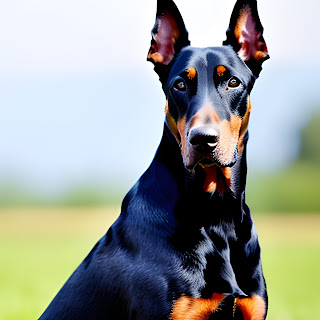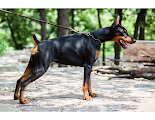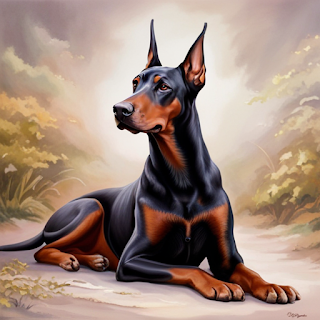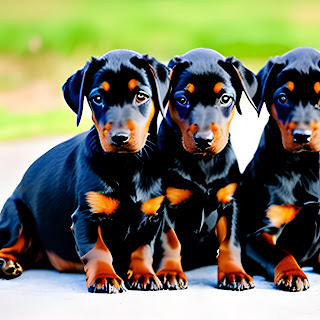The Doberman Dog Breed Profile: Guide to its History and Origins
The Doberman Pinscher, commonly known as the Doberman or Dobie, is a powerful and intelligent breed with a rich history. Known for their loyalty, agility, and protective instincts, these dogs have become popular companions and working partners for many dog enthusiasts. In this comprehensive breed profile, we will delve into the history and origins of the Doberman, exploring the factors that shaped this remarkable breed.
According to the American Kennel Club (AKC), the Doberman Pinscher is a very intelligent breed, ranking 5th out of 197 breeds in terms of trainability. They are known for their ability to learn quickly and respond well to positive reinforcement training. They are also highly adaptable and can excel in a variety of activities, including obedience, agility, and tracking. Here is an article on the top 5 intelligent dogs.
History and Origins
The Doberman Pinscher was developed in Germany during the late 19th century by a tax collector named Karl Friedrich Louis Dobermann. His goal was to create a breed that would serve as both a loyal companion and an effective guard dog to protect him during his tax collection rounds. To achieve this, Dobermann carefully selected various breeds, including the Rottweiler, German Pinscher, Weimaraner, Greyhound, and possibly the Beauceron and Manchester Terrier.
The result was a medium-to-large dog with a sleek, muscular build, remarkable intelligence, and unwavering loyalty. The breed quickly gained popularity in Germany, and by the early 20th century, it had spread to other parts of Europe and the United States. During World War II, Dobermans were used as messenger dogs, sentinels, and search-and-rescue dogs by the US Marine Corps. Their service earned them a reputation as fearless and dependable working dogs.
Physical Characteristics
The Doberman is a muscular and athletic breed that stands between 24 to 28 inches tall at the shoulder and weighs between 60 to 100 pounds. They have a sleek coat that comes in four primary colors: black, red, blue, and fawn, all with rust markings above the eyes, on the muzzle, chest, legs, and tail.
Their heads are wedge-shaped with alert, almond-shaped eyes that convey their intelligence and focus. The ears of a Doberman are naturally floppy but are often cropped to stand erect – a practice that remains controversial. The tail is typically docked short but can be left natural in some countries where docking is banned.
The Doberman dog breed has been a subject of controversy for many years due to the practice of cropping their ears. Ear cropping is a surgical procedure that involves removing a portion of the dog's ear to make it stand upright. This practice was initially done to prevent ear infections and improve the dog's hearing.
However, in recent years, many animal welfare organizations have criticized the practice as unnecessary and cruel. They argue that ear cropping is a painful procedure that can cause lasting physical and emotional harm to the dog. Additionally, many countries have banned ear cropping, including the United Kingdom, Australia, and parts of Europe.
Despite this, ear cropping remains legal in some countries, including the United States. Many Doberman breeders continue to crop their dogs' ears for aesthetic reasons, arguing that it is necessary to maintain the breed's appearance and prestige. They claim that cropped ears make the dog look more intimidating and alert.
The controversy over cropping Doberman ears is unlikely to be resolved anytime soon. While some breeders and owners continue to support the practice, others are calling for a ban on ear cropping to protect the welfare of these beloved dogs. It remains up to individual owners and breeders to decide whether or not to crop their dog's ears, but it is important to consider the potential risks and benefits before making a decision.
Temperament and Personality
Dobermans are known for their intelligence, loyalty, and protective instincts. They form strong bonds with their families and are often described as "velcro dogs" because they want to be close to their owners at all times. This breed is highly trainable and excels in various dog sports such as obedience, agility, and Schutzhund.
Doberman dog breed is known for its temperament, which is a combination of loyalty, intelligence, and protectiveness. They are highly energetic and require regular exercise to maintain their physical and mental health. Dobermans are also known for their obedience and willingness to please their owners. However, they can be wary of strangers and may exhibit aggression if not properly trained and socialized. With proper training and socialization, Dobermans can make excellent family pets and loyal companions. Overall, the temperament of a Doberman is a reflection of their upbringing and training, making it important for owners to invest time and effort in their care.
Doberman dogs are known to be prone to separation anxiety Like many other breeds, they form strong bonds with their owners and can become anxious or distressed when left alone for extended periods of time. It's important to provide them with plenty of exercise, mental stimulation, and positive reinforcement training to help alleviate their anxiety.
While they may have a reputation for being aggressive, a well-socialized Doberman is typically friendly towards strangers and other dogs. However, their protective instincts make them excellent watchdogs who will not hesitate to defend their family if they perceive a threat.
Health and Lifespan
Dobermans have an average lifespan of 10 to 12 years. Like any breed, they can be prone to specific health issues. Some common health concerns include hip dysplasia, dilated cardiomyopathy (a heart condition), von Willebrand's disease (a bleeding disorder), and progressive retinal atrophy (an eye condition). Regular check-ups with a veterinarian and appropriate screening tests can help detect and manage these conditions.
Grooming Your Doberman
Grooming a Doberman Pinscher is an important aspect of their overall health and well-being. These dogs have a short, sleek coat that requires minimal grooming, but it still needs to be done regularly.
To groom a Doberman, start by brushing their coat with a soft-bristled brush to remove any loose hair and dirt. This will also help distribute the natural oils in their coat, keeping it shiny and healthy. Be sure to pay special attention to the areas behind their ears, under their armpits, and around their tail where matting can occur.
Next, trim their nails using a sharp nail clipper designed for dogs. Dobermans are active dogs, so their nails can grow quickly and become too long, causing discomfort and potential injury.
Finally, clean their ears using a cotton ball or pad dampened with a gentle ear cleaner. This will help prevent ear infections and keep their ears smelling fresh.
Overall, grooming a Doberman Pinscher is a simple process that can be done at home with just a few tools and some patience. By keeping up with regular grooming, you can help your Doberman look and feel their best.
Doberman Pinscher puppies can vary in cost depending on a few factors such as location, breeder reputation, and lineage. On average, expect to pay anywhere from $1,500 to $2,500 for a Doberman puppy. It's important to do your research and find a reputable breeder to ensure you are getting a healthy and well-bred puppy. Additionally, keep in mind that owning a dog comes with ongoing costs such as food, veterinary care, and supplies.
Here are five frequently asked questions about the Doberman dog breed:
1. What is the origin of the Doberman breed?
The Doberman breed was developed in Germany in the late 19th century by a tax collector named Louis Dobermann. He wanted a dog that could protect him while he was on his rounds, and he bred several different types of dogs to create the Doberman.
2. What is the temperament of the Doberman?
Dobermans are known for being loyal, intelligent, and protective. They can be wary of strangers and are often used as guard dogs, but they are also affectionate with their families and enjoy spending time with them.
3. Are Dobermans good with children?
Dobermans can be good with children if they are socialized properly from a young age. However, they are large dogs and can be very energetic, so they may accidentally knock over small children. It's important to supervise interactions between children and Dobermans to ensure everyone stays safe.
4. What health problems are common in Dobermans?
Dobermans are prone to several health issues, including hip dysplasia, heart problems, and von Willebrand's disease (a bleeding disorder). It's important to buy a Doberman from a reputable breeder who screens their dogs for these and other health issues.
5. How much exercise does a Doberman need?
Dobermans are high-energy dogs and require a lot of exercise. They should be walked or run for at least an hour a day, and they also benefit from other forms of exercise like playing fetch or going for a swim. Without enough exercise, Dobermans can become bored and destructive.
A Dobie Named Cappy
Cappy was a remarkable Doberman Pinscher who served in the United States Marine Corps during World War II. This brave dog saved the lives of 250 people during his service. Cappy was trained as a war dog and was sent to the Pacific Theatre of Operations where he served with distinction. He was trained to detect enemy soldiers and was often used to patrol beaches and other areas where enemy troops were likely to be hiding.
Cappy's training and instincts proved invaluable on many occasions. He was able to detect enemy soldiers who were hiding in bunkers and other concealed locations, allowing his handlers to take them out before they could cause any harm. Cappy was also trained to locate injured soldiers and bring them back to safety.
Conclusion
The Doberman Pinscher is a remarkable breed with a fascinating history that reflects its unique combination of intelligence, loyalty, and physical prowess. As companions or working partners, these dogs are sure to impress with their dedication and ability to excel in various tasks. By understanding a dog's history and origins, we can appreciate the qualities that make the Doberman such a beloved breed among dog enthusiasts worldwide.
.jpg)


.jpg)
.png)

.png)
.jpg)
.jpg)
